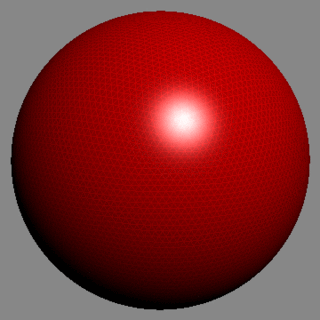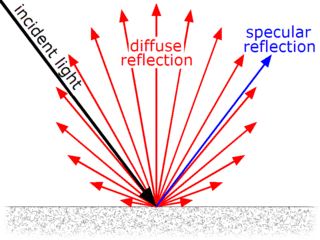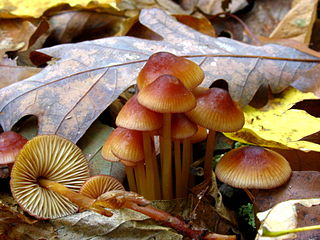
Rendering or image synthesis is the automatic process of generating a photorealistic or non-photorealistic image from a 2D or 3D model by means of computer programs. Also, the results of displaying such a model can be called a render. A scene file contains objects in a strictly defined language or data structure; it would contain geometry, viewpoint, texture, lighting, and shading information as a description of the virtual scene. The data contained in the scene file is then passed to a rendering program to be processed and output to a digital image or raster graphics image file. The term "rendering" may be by analogy with an "artist's rendering" of a scene.

In mathematics, the four color theorem, or the four color map theorem, states that, given any separation of a plane into contiguous regions, producing a figure called a map, no more than four colors are required to color the regions of the map so that no two adjacent regions have the same color. Adjacent means that two regions share a common boundary curve segment, not merely a corner where three or more regions meet. It was the first major theorem to be proved using a computer. Initially, this proof was not accepted by all mathematicians because the computer-assisted proof was infeasible for a human to check by hand. Since then the proof has gained wide acceptance, although some doubters remain.

The Persistence of Vision Ray Tracer, or POV-Ray, is a ray tracing program which generates images from a text-based scene description, and is available for a variety of computer platforms. It was originally based on DKBTrace, written by David Kirk Buck and Aaron A. Collins for the Amiga computers. There are also influences from the earlier Polyray raytracer contributed by its author Alexander Enzmann. POV-Ray is free and open-source software with the source code available under the AGPLv3.

Shading refers to depicting depth perception in 3D models or illustrations by varying levels of darkness.
TrueSpace was a commercial 3D computer graphics and animation software developed by Caligari Corporation, bought-out by Microsoft. As of May 2009, it was officially discontinued, but with some 'unofficial support' up to February 2010.

Diffuse reflection is the reflection of light or other waves or particles from a surface such that a ray incident on the surface is scattered at many angles rather than at just one angle as in the case of specular reflection. An ideal diffuse reflecting surface is said to exhibit Lambertian reflection, meaning that there is equal luminance when viewed from all directions lying in the half-space adjacent to the surface.

A lightmap is a data structure used in lightmapping, a form of surface caching in which the brightness of surfaces in a virtual scene is pre-calculated and stored in texture maps for later use. Lightmaps are most commonly applied to static objects in applications that use real-time 3D computer graphics, such as video games, in order to provide lighting effects such as global illumination at a relatively low computational cost.

Path tracing is a computer graphics Monte Carlo method of rendering images of three-dimensional scenes such that the global illumination is faithful to reality. Fundamentally, the algorithm is integrating over all the illuminance arriving to a single point on the surface of an object. This illuminance is then reduced by a surface reflectance function (BRDF) to determine how much of it will go towards the viewpoint camera. This integration procedure is repeated for every pixel in the output image. When combined with physically accurate models of surfaces, accurate models of real light sources, and optically correct cameras, path tracing can produce still images that are indistinguishable from photographs.
form·Z is a computer-aided (CAD) design tool developed by AutoDesSys for all design fields that deal with the articulation of 3D spaces and forms and which is used for 3D modeling, drafting, animation and rendering.
Computer graphics lighting refers to the simulation of light in computer graphics. This simulation can either be extremely accurate, as is the case in an application like Radiance which attempts to track the energy flow of light interacting with materials using radiosity computational techniques. Alternatively, the simulation can simply be inspired by light physics, as is the case with non-photorealistic rendering. In both cases, a shading model is used to describe how surfaces respond to light. Between these two extremes, there are many different rendering approaches which can be employed to achieve almost any desired visual result.
Color bleeding may refer to:
In radiometry, radiosity is the radiant flux leaving a surface per unit area, and spectral radiosity is the radiosity of a surface per unit frequency or wavelength, depending on whether the spectrum is taken as a function of frequency or of wavelength. The SI unit of radiosity is the watt per square metre, while that of spectral radiosity in frequency is the watt per square metre per hertz (W·m−2·Hz−1) and that of spectral radiosity in wavelength is the watt per square metre per metre (W·m−3)—commonly the watt per square metre per nanometre. The CGS unit erg per square centimeter per second is often used in astronomy. Radiosity is often called intensity in branches of physics other than radiometry, but in radiometry this usage leads to confusion with radiant intensity.
False Radiosity is a 3D computer graphics technique used to create texture mapping for objects that emulates patch interaction algorithms in radiosity rendering. Though practiced in some form since the late 90s, this term was coined only around 2002 by architect Andrew Hartness, then head of 3D and real-time design at Ateliers Jean Nouvel.

Mycena sanguinolenta, commonly known as the bleeding bonnet, the smaller bleeding Mycena, or the terrestrial bleeding Mycena, is a species of mushroom in the Mycenaceae family. It is a common and widely distributed species, and has been found in North America, Europe, Australia, and Asia. The fungus produces reddish-brown to reddish-purple fruit bodies with conic to bell-shaped caps up to 1.5 cm (0.6 in) wide held by slender stipes up to 6 cm (2.4 in) high. When fresh, the fruit bodies will "bleed" a dark reddish-purple sap. The similar Mycena haematopus is larger, and grows on decaying wood, usually in clumps. M. sanguinolenta contains alkaloid pigments that are unique to the species, may produce an antifungal compound, and is bioluminescent. The edibility of the mushroom has not been determined.

Mycena atkinsoniana is a species of agaric fungus in the Mycenaceae family. It is one of the so-called "bleeding mycenas" that will ooze yellow to orange juice when injured. Other distinguishing features include the upper stem surface that is decorated with tiny purplish-brown fibers, and the gills, which are pale yellow with maroon edges. The reddish-brown caps are smooth with a grooved margin, and up to 3 cm (1.2 in) wide. Mycena atkinsoniana is known from the United States and Canada, where it grows scattered or in groups on leaf litter in forests during the summer and autumn. It was originally described from collections associated with beech, but it is also frequently found under eastern North American oaks.














